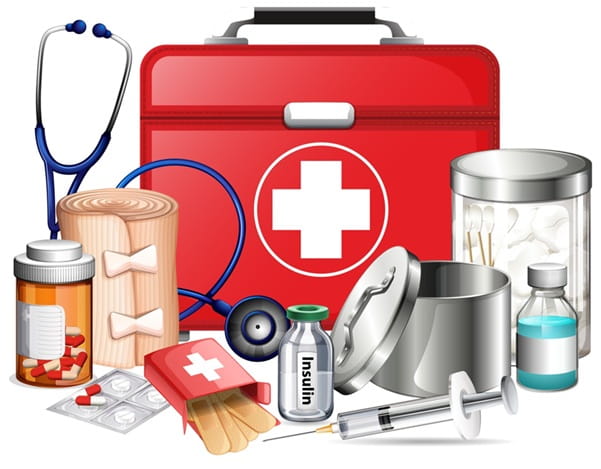INTRODUCTION:
Advanced Cardiovascular Life Support (ACLS) is a critical skill set for healthcare providers who respond to cardiovascular emergencies. In such high-stakes situations, having a well-equipped and reliable emergency medical kit can mean the difference between life and death. Whether you’re a paramedic, emergency room nurse, physician, or part of a critical response team, selecting the right ACLS kit is essential.
This guide explores the key factors to consider when choosing an ACLS emergency kit, helping you tailor your decision to the needs of your team, environment, and patient population.

UNDERSTANDING THE PURPOSE OF AN ACLS EMERGENCY MEDICAL KIT:
An ACLS emergency kit is designed to provide immediate access to life-saving tools and medications during cardiac and respiratory emergencies. These kits are often deployed in hospitals, ambulances, clinics, and even in remote field locations where every second counts.
Unlike a general first aid kit, an ACLS kit includes specialized items for managing arrhythmias, respiratory distress, cardiac arrest, and other critical conditions. acls renewal online courses often review the use of medications such as epinephrine, amiodarone, and atropine, which are staples alongside airway management tools and defibrillation equipment.
The core idea is readiness. The kit must be organized, portable, and comprehensive enough to support the advanced interventions required by ACLS protocols.
KEY COMPONENTS OF A STANDARD ACLS KIT:
Although the specific contents of ACLS kits may vary depending on the provider or setting, there are essential items that most kits should include:
- Airway Management Tools: Endotracheal tubes, laryngoscopes, bag valve masks (BVMs), oral airways, suction devices.
- Defibrillation Supplies: Automated external defibrillators (AEDs) or manual defibrillators with pads or paddles.
- IV/IO Access Equipment: Catheters, needles, syringes, saline flushes, and intraosseous kits.
- Emergency Medications: Common ACLS drugs like epinephrine, amiodarone, atropine, lidocaine, and others.
- Monitoring Devices: Portable ECG monitors, pulse oximeters, and capnography tools.
- Documentation Tools: Checklists, medication logs, and patient tracking forms.
- PPE and Infection Control: Gloves, masks, and sanitizer for provider safety.
FACTORS TO CONSIDER WHEN CHOOSING AN ACLS EMERGENCY KIT:
When selecting an ACLS kit, it’s not just about checking off a list of items. The ideal kit should match the realities of your clinical environment, staff training levels, and expected patient scenarios. Here are the main factors to consider:
1. ENVIRONMENT AND USE CASE
Think about where the kit will be used. A hospital crash cart and a rural EMS bag have different design needs.
- In-hospital Use: May require a larger, wheeled cart with more comprehensive tools and medications, organized into clearly labelled drawers.
- Prehospital or Field Use: Needs to be more compact, durable, and easily portable. Weather-resistant cases or backpacks are ideal for remote or outdoor settings.
- Transport Settings: Air ambulances or critical care transport units might require specialized kits with secured compartments and space-saving layouts.
Understanding your operational context will help guide the type, size, and features of the kit you choose.
2. SCOPE OF PRACTICE
The level of care your team is authorized and trained to provide directly influences what should be in your kit.
- Basic Life Support (BLS) Providers: May not need advanced airway or drug administration tools.
- Paramedics and Physicians Require advanced tools and medications, including IV/IO access supplies and cardiac drugs.
- Multi-disciplinary Teams: May benefit from modular kits that separate equipment by provider type or use.
The kit should match the licensure level and protocols of the responding personnel.
3.ORGANIZATION ANDACCESSIBILITY
In an emergency, time is everything. Kits must be organized in a way that makes supplies immediately accessible.
- Color-coded compartments and clearly labelled pouches improve speed and reduce errors.
- Customizable modules allow organizations to tailor kits to their team’s preferences.
- Checklists should be included to ensure nothing critical is missing or expired.
Well-organized kits reduce confusion, especially in chaotic or stressful situations.
4. PORTABILITY AND DURABILITY
In mobile or field environments, how a kit is carried and protected matters. Backpacks and soft bags are ideal for EMS and remote teams.
- Hard casesprotect harsh environments but may be heavier.
- Water-resistant or waterproof materials are important for outdoor or marine use.
5. COMPLIANCE AND STANDARDIZATION
Many healthcare settings are governed by regional, national, or institutional protocols that dictate the equipment and medications that must be available.
- Ensure your kit complies with local emergency medical services regulations and ACLS algorithms.
- Stay up-to-date with changes from the American Heart Association (AHA) and other relevant authorities.
- Standardization across teams can help when multiple providers use the same equipment.
6. REPLENISHMENT AND RESTOCKING EASE
Emergency kits are only effective if they’re kept up to date. Consider the ease of restocking when choosing your kit.
- Pre-configured refill kits or modular supply packs can save time.
- Inventory tracking systems or built-in checklists make it easier to maintain the kit.
- Expiration date visibility on medications is crucial for patient safety.
CUSTOMIZATION: ONE SIZE DOESN’T FIT ALL:
While some providers opt for standardized ACLS kits, others prefer a more tailored approach. Many manufacturers offer customization options so that facilities or providers can design kits around their unique needs.
Custom kits may include:
- Specialized pediatric or neonatal modules
- Additional trauma supplies for EMS or battlefield medicine
- Language-specific instructions for multilingual teams
- Integration with electronic medical records (EMR) or barcode systems
Although customization may increase initial cost, it often improves performance and efficiency in the long run.
CONCLUSION: PREPAREDNESS IS EVERYTHING:
In emergencies involving cardiac arrest, severe arrhythmias, or respiratory failure, seconds can mean survival or loss. A well-chosen ACLS emergency kit serves as a frontline ally, equipping providers with the tools they need to act decisively.
When selecting your kit, take a holistic view: consider where it will be used, who will use it, what it must include, and how easily it can be maintained. Training and customization can further enhance the effectiveness of your emergency response.
